By Luke Slattery
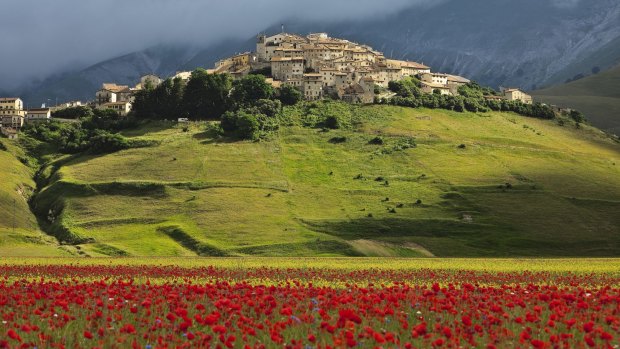
The spectacular Castelluccio landscape in Umbria.Credit: Eric Van Den Brulle
It was late on a cold spring afternoon when I came down off Mount Subasio after a five-hour trek from the pilgrim town of Assisi, thighs burning, hiking boots caked with mud. The rain had just begun to clear when I stumbled, almost tripping over myself, down Subasio's south-west slope. And there, its walls of biscuit-coloured stone bathed in a soft slanting light, stood lovely Spello.
The enchantments of this Umbrian town, a warren of harmonious stone dwellings forested with spires and belfries and bluff arrowslit strongholds, have drawn me back again. But things are different now. We're staying not at a B&B but a beautifully restored stone cottage and the population has grown. Stepping out for an evening meal I notice there are couples strolling along twisting cobbled lanes that had once seemed the haunts of ghosts and memories.
We find a family-run restaurant with a courtyard open to a street along which no vehicle ever seems to run, possibly because it's only as wide as a Roman ox-cart. The restaurant is named after Pinturicchio, the Renaissance artist born in nearby Perugia who famously frescoed Spello's Baglioni Chapel. I tuck into a meal of pasta tossed with mushrooms and truffle oil – truffles appear in some guise on every Umbrian menu – followed by what looks like half a flame-grilled wild boar. The wine list is impressive, but I keep it simple and settle for Sagrantino, an intense red produced from a local grape grown at nearby Montefalco, and very Australian in character.
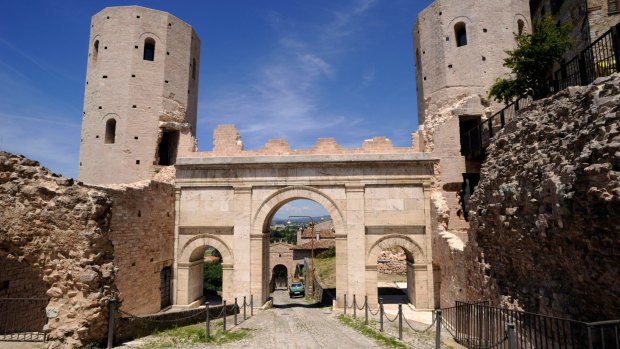
A Roman gate at Spello.Credit: Alamy
In the morning, we have breakfast on a belvedere beside our cottage. It's early autumn, and the leaves of the persimmon above have crisped and curled, and some of the yolk-yellow fruit lie at my feet. Mist hangs in the valley. The swimming pool in our garden remains undisturbed. When the sun begins to climb we have a fine view west over a plain of pastures and olive groves bordered by stands of cypress, receding in sharp angles towards the richly forested Apennines – the source of that wild boar.
I ask my host, Andrea Faulkner, about the changes. "You find a lot of Italians still haven't heard of Spello," she says. "But foreigners" – an Austrian, she is one of them, though has lived here for many years – "come in increasing numbers to restore the houses. And Italian foodies come up for weekends."
The rest of Italy seems to be in a slough of depression, but here in Spello there's a revival under way. The town was founded by Caesar Augustus in the 1st century BC and its roots of Roman travertine are much in evidence along the old city walls. Spello, originally Hispellum, is proud of its antique provenance and the oldest structures, such as the Roman Gate of Venus, have been restored to a parchment white.
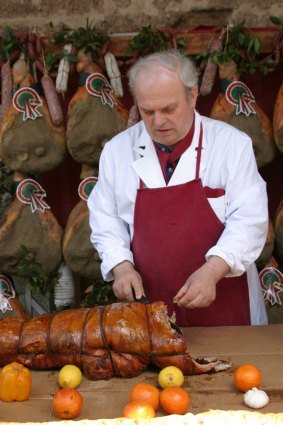
Roasted and spiced whole pig being sliced for sandwiches.Credit: Alamy
But this old walled town will always be, in essence, a sweet fragment of the medieval world and very typical of Umbria. The region stands apart from the famed Renaissance strongholds of Tuscany and, for that matter, the everyday life of contemporary Italy. There is a meditative pre-modern stillness about the Umbrian townscapes.
Step into the Baglioni Chapel along the left aisle of the Romanesque Church of Santa Maria Maggiore, and you enter a time machine. The same could be said, to some extent, of any intact Italian church built in Christianity's golden years. But it's particularly true of this chapel, whose three walls Pinturicchio frescoed in 1500 with scenes from the early life of Jesus, including the Annunciation, while on the cross-vault above he painted four enthroned Sibyls. These legendary oracles look, all alone up there in Renaissance garb, like ladies of Shalott.
Standing in the chapel you can, quite literally, turn your back on reality and enter Pinturicchio's dream world of extraordinary colour, sweetness and grace. Even in the artist's lifetime it must have been a refuge from the all too real-life Borgias mini-series ravaging Italy.
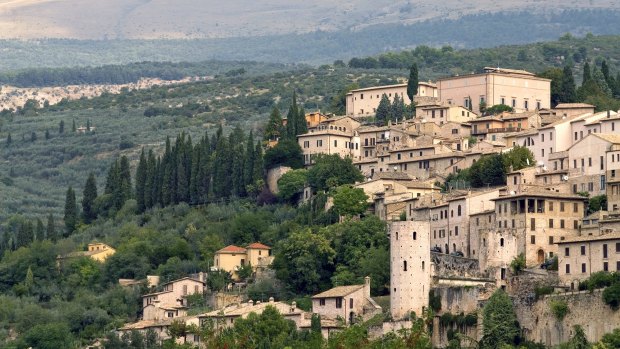
The historical town centre of Spello with the Monte Subasio in the background.Credit: Getty Images
After espresso at a counter wedged between shops selling local salume and truffles, I rejoin the 21st century on the motorway heading west. On that earlier visit I travelled on foot from Assisi to Spello and then onward to Orvieto, Montefalco, Todi and Spoleto: each one commanding a hilltop. The trick is knowing what to revisit and what to discover. But the decision is taken out of our hands by an Italian couple, friends from Sydney who have since returned home, and they are keen to show us their Umbria.
We circumnavigate Lake Trasimeno, which lies at the western edge of Umbria bordering Tuscany, climbing to the castellated hilltop town of Panicale. Little known outside Italy, this is a perfect sanctuary of stone and russet brick. Its cobbled streets, bridged and buttressed here and there with arches, radiate from a piazza with a 15th-century fountain at its core. Its churches are ornamented with Renaissance artworks, including a recently cleaned Martyrdom of Saint Sebastian by Perugino, a local boy. Where Spello cascades down its hillside, Panicale is perched at eagle height, with views towards the lake on one side and a chain of forested hills on the other.
The next stop, Perugia, doesn't quite pale in comparison – Perugia is an incomparably rich microcosm of the medieval world. But it is a city: Umbria's capital no less. And on a day when a chocolate festival has drawn crowds, the Willy Wonka atmosphere is a little overwhelming. We do the sights, sheltering for a time in a perfect Gothic chapel, Saint Agatha, still under restoration. One fresco, deeply strange, depicts a kind of sci-fi Christ with three faces. Afterwards, we return by road to Spello and arrive just as evening steals away the last rays of daylight.
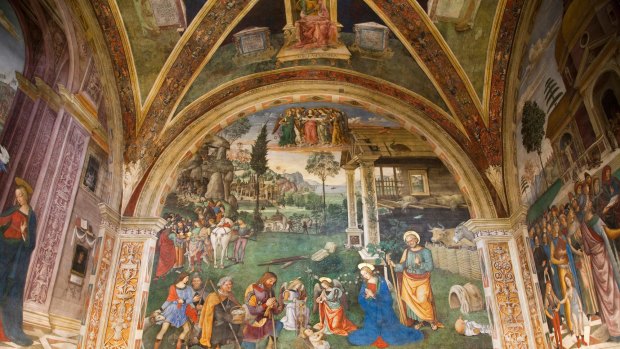
Pinturicchio's frescoes at Santa Maria Maggiore.Credit: Alamy
On this second visit to Umbria I begin to suffer from that common affliction of foreigners: the yearning for a new – an Italian – life. I ask Andrea if there's anything for sale in town. "Yes, of course," she says. "They come to see if I want to restore them. But I've just finished this," she gestures at the restored honey-coloured brick of Casa Giardino where we're staying, the latest in a clutch of Spello holiday villas she has restored and furnished with chic bowerbird style and an eye to home-away-from-home comfort.
We swap our garden view for one from "the balcony of Umbria": the lovely town Montefalco for a lunch of Sagrantino, and regional fare at a restaurant overlooking our destination later that day, the Sibylline mountains ranging across the south-east. Legend has it that the all-seeing Sibyl retired to these peaks; until the last generation Umbrian children were raised to believe that witches and demons still dwelt here.
It's evening when we pull into Norcia. The town holds a special place in the Italian gastronomic world, where it is famed for its hams and sausages made from wild boar and pork. So fine and varied are its smallgoods, Norcia lends its name to the Italian word for particularly high-grade artisanal salami and prosciutto: norcineria. The wild boar is something of a civic mascot; stuffed versions stand outside every delicatessen, and there's even souvenir toy boars for sale – wild no longer.
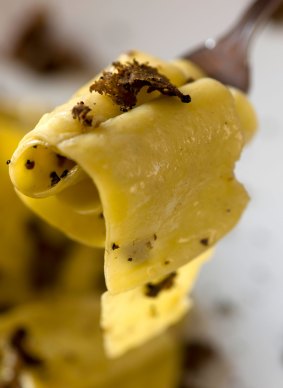
Pappardelle with Norcia truffles.Credit: Alamy
Streets flanked by norcineria lead to a piazza and the Gothic Church of Saint Benedict, where we head for evening vespers – hymns before drinks – sung by a choir of Benedictine monks in distinctively hooded black habits. The deeply meditative ritual of evensong has not changed in centuries, though in the gloom I notice one of the monks, doubtless a novice, is following the ethereal chant in the glow of an iPad.
The next morning we strike deeper into the Sibylline range towards one of Umbria's, and perhaps Italy's, chief glories. We reach the great plain of Castelluccio after an hour of mountain driving, often at tree-line height, plunging finally down a straight ribbon of road flanked on either side by pasture: the habitat of shepherds and Italian cowboys, who may or may not be wearing Valentino riding boots.
In winter the valley is an ocean of mist pierced by a chain of white peaks. But in spring the plain, nourished by snowmelt, is sown with lentil and rapeseed, and carpeted with wildflowers – and it quickly morphs into a vivid patchwork of violet, scarlet, emerald green and yellow.
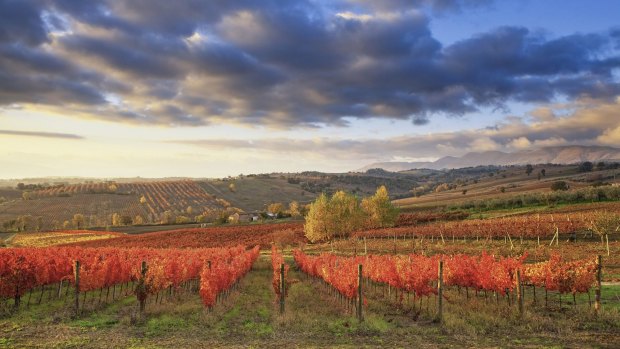
Dawn over the Sagrantino vineyards near Montefalco in Umbria.Credit: Slow Images
In autumn it is only a slightly less spectacular sight, with the great sheer rump of Mount Vettore rearing up to nearly 2500 metres behind the hamlet of Castellucio. It is little more than a knuckle of bare stone dwellings gathered, along with 150 townsfolk, around a couple of campanile. We step out of the car into this heroic landscape for a stretch of the legs, but the wind beating down from the mountain sends us scurrying back. There's not a soul on the streets.
On the way out of the valley we notice a shaggy sheep, bleating beside the road, separated from its flock. Suddenly there's a vicious snarling at the window and two sheep dogs the size of small horses lunge theatrically at our tyres. I look back and watch them settle again, unperturbed, in the autumn sun. A little further east, just over the Sibylline mountains, lies the Marche, and beyond it the Adriatic; to the west is Florence, a city owned by the world. Landlocked Umbria, in contrast, seems so far from everywhere, and from everyone, even though it is not. It is Italy's green, and its hidden, heart.
TRIP NOTES
MORE INFORMATION
GETTING THERE
Cathay Pacific flies four times daily from Sydney to Milan or Rome and three times daily Melbourne to Milan or Rome. See www.cathaypacific.com.au. From Rome, Spello is a 2¼-hour drive or two hours by train via Foligno.
STAYING THERE
Andrea Faulkner has three carefully restored holiday villas in Spello, each with panoramic views and high-end appointments. Available for weekly rental, from $2350. See www.buonanottebarbanera.it.
The writer flew as a guest of Cathay Pacific Airways.
Sign up for the Traveller Deals newsletter
Get exclusive travel deals delivered straight to your inbox. Sign up now.